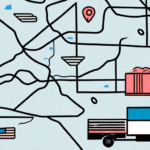Introduction: Finding the Right Delivery Service for Your Needs
When it comes to shipping and receiving packages, selecting the right delivery service can significantly impact the efficiency and reliability of your operations. By identifying your specific delivery requirements and evaluating the quality and reliability of various providers, you can make an informed decision that best suits your needs. In this guide, we will explore the key factors to consider when choosing a delivery service.
Identifying Your Delivery Needs
Before selecting a delivery service, it's crucial to assess your specific shipping requirements. Consider the following questions:
- What type of package are you shipping? (e.g., documents, electronics, perishable goods)
- What is the package's size and weight?
- Are there any fragile or valuable items that require special handling?
- What is the destination of the shipment? (domestic or international)
- What is the required delivery timeframe? (e.g., same-day, overnight, standard)
- Do you need tracking and insurance options?
Additionally, consider whether the delivery location is a residential or commercial address and if there are any specific delivery instructions or restrictions.
Understanding the Types of Delivery Services Available
Delivery services come in various forms, each suited to different needs. Understanding the types of delivery services available can help you choose the best option for your shipment.
Standard Ground Shipping
Standard ground shipping is the most cost-effective option for non-urgent packages. It typically takes 3-7 business days for delivery within the same country. Services like UPS Ground and Amazon Logistics offer reliable ground shipping options.
Express Shipping
Express shipping guarantees faster delivery, usually within 1-3 business days. This option is ideal for time-sensitive shipments. Providers like FedEx Express and DHL Express offer expedited shipping services.
Overnight Shipping
Overnight shipping is the fastest delivery option, ensuring your package arrives by the next business day. This service is essential for urgent shipments but comes at a higher cost. Companies such as FedEx Overnight and USPS Priority Mail Express provide overnight shipping solutions.
The Pros and Cons of Different Delivery Options
Each delivery option has its advantages and drawbacks. Understanding these can help you make an informed decision based on your specific needs.
Standard Ground Shipping
- Pros: Cost-effective for non-urgent shipments, wide coverage area.
- Cons: Longer delivery times compared to expedited options.
Express Shipping
- Pros: Faster delivery times, suitable for time-sensitive packages.
- Cons: Higher costs compared to standard shipping.
Overnight Shipping
- Pros: Guaranteed next-day delivery, essential for urgent shipments.
- Cons: Most expensive shipping option.
Ultimately, the type of delivery service you choose will depend on your package's size, weight, distance, and the urgency of delivery.
Choosing a Delivery Service Based on Your Budget
Shipping costs can vary widely depending on the service type, package size, weight, and destination. Here are some strategies to manage your shipping budget effectively:
- Compare Shipping Rates: Use comparison tools to evaluate rates from different carriers.
- Optimize Package Size and Weight: Smaller and lighter packages generally cost less to ship.
- Negotiate Rates: If you ship frequently, negotiate bulk rates with your chosen carrier.
According to a PwC Shipping Report, effective cost management is essential for maintaining profitability in logistics operations.
Evaluating the Delivery Timeframe: How Fast Do You Need It?
In addition to cost, the delivery timeframe is a critical factor in selecting a delivery service. Different services offer varying delivery speeds:
- Same-Day Delivery: Ideal for urgent packages, often available in metropolitan areas.
- Next-Day Delivery: Suitable for time-sensitive shipments that require overnight delivery.
- Standard Delivery: Best for non-urgent packages with flexible delivery schedules.
It's also important to consider the recipient's location. Deliveries to remote or rural areas may require longer timeframes or specialized services. Planning ahead, especially during peak seasons, can help ensure timely deliveries.
Examining the Quality and Reliability of Different Delivery Providers
Reliability is paramount when selecting a delivery provider. Here are key aspects to evaluate:
- Delivery Success Rate: Research the carrier's track record for on-time and accurate deliveries.
- Customer Service: Responsive and helpful customer support can resolve issues promptly.
- Technology and Tracking: Advanced tracking systems provide visibility and transparency.
According to a Statista report, consumers prioritize reliability and transparency in delivery services, making these factors crucial for customer satisfaction.
Comparing Shipping Rates and Fees Across Different Carriers
Shipping rates and additional fees can significantly impact your overall costs. Here's how to compare effectively:
- Base Rates: Compare the fundamental shipping costs based on package size, weight, and destination.
- Additional Fees: Watch for extra charges like fuel surcharges, residential delivery fees, and remote area surcharges.
- Discounts and Promotions: Many carriers offer discounts for bulk shipments or frequent shippers.
Shipping rates can also vary depending on the destination and package specifics. It's beneficial to utilize online rate calculators provided by carriers like UPS, FedEx, and DHL to obtain accurate comparisons.
Checking for Additional Services Offered by Delivery Companies
Many delivery companies provide additional services that can enhance your shipping experience:
- Package Tracking: Monitor your shipment's progress in real-time.
- Proof of Delivery: Obtain confirmation that the package was received.
- Insurance: Protect your shipment against loss or damage.
- Signature Requirements: Ensure secure delivery by requiring a signature upon receipt.
Evaluate whether these services are included in the base price or if they incur additional fees. Determine which extras are valuable based on the nature of your shipments.
Reading Reviews and Testimonials from Other Customers
One of the best ways to gauge the quality and reliability of a delivery service is by reading reviews and testimonials from other customers. Here's how to approach it:
- Online Reviews: Check platforms like Trustpilot, Sitejabber, and the Better Business Bureau for feedback.
- Case Studies: Look for case studies or success stories on the carrier's website.
- Social Media: Monitor social media channels for real-time customer experiences.
Pay attention to recurring themes in feedback, such as consistent delivery delays or exceptional customer service, to inform your decision.
Negotiating Better Rates with Your Chosen Delivery Service
If you plan to use a particular delivery service frequently, you may have the opportunity to negotiate better rates. Consider the following strategies:
- Bulk Shipping: Carriers often offer discounts for high-volume shippers.
- Long-Term Contracts: Committing to a long-term partnership can secure more favorable rates.
- Competitive Bidding: Obtain quotes from multiple carriers and use them to negotiate better terms.
Establishing a strong relationship with your carrier can also lead to additional benefits, such as priority support and access to exclusive services.
Preparing Your Package for Safe and Secure Shipping
Proper package preparation is essential to protect your items and ensure successful delivery. Follow these best practices:
- Use Appropriate Packaging: Invest in sturdy boxes and adequate cushioning materials to protect your items.
- Seal Packages Securely: Use high-quality packing tape to seal all openings and reinforce corners if necessary.
- Label Clearly: Ensure that both the sender's and recipient's addresses are legible and include all necessary information.
- Follow Carrier Guidelines: Each carrier may have specific packaging requirements regarding size, weight, and materials.
For detailed packaging guidelines, refer to the UPS Packaging Guide.
Tracking Your Shipment: Tips and Tools for Staying Informed
Tracking your shipments provides visibility and peace of mind. Most delivery services offer tracking features that allow you to monitor your package's progress in real-time.
- Use Tracking Numbers: Each shipment is assigned a unique tracking number that can be used to check its status online.
- Set Up Notifications: Many carriers offer email or SMS notifications to keep you updated on your package’s status.
- Leverage Carrier Apps: Mobile applications from carriers like FedEx and DHL provide convenient tracking options on the go.
Keep in mind that tracking information may occasionally be delayed or inaccurate due to unforeseen circumstances like weather conditions or technical issues. If you encounter any discrepancies, contact the carrier’s customer support for assistance.
Dealing with Common Issues in Shipping and Receiving Packages
Despite careful planning, issues can arise during the shipping process. Being prepared to handle common challenges can help mitigate potential problems.
Managing Delays
Delays can occur due to various factors, including weather disruptions, customs processing, or high shipping volumes during peak seasons. To manage delays:
- Choose carriers with reliable on-time delivery records.
- Plan shipments well in advance, especially during holidays.
- Opt for expedited shipping if timely delivery is crucial.
Handling Damaged or Lost Packages
If your package arrives damaged or is lost, take the following steps:
- Immediately contact the delivery provider’s customer service.
- Provide necessary documentation, such as tracking numbers and photos of the damage.
- Familiarize yourself with the carrier's claims process to expedite resolution.
Refer to the FedEx Customer Support or the respective carrier’s support page for assistance.
Conclusion: Finding the Best Delivery Service to Meet Your Needs
Choosing the right delivery service involves carefully assessing your shipping needs, understanding available service types, evaluating providers, managing costs, and preparing your packages properly. By following these guidelines and leveraging reputable carriers, you can ensure efficient and reliable delivery for your shipments.
Remember to regularly review and adjust your shipping strategies to accommodate changing needs and market conditions, ensuring you maintain optimal delivery performance.




















